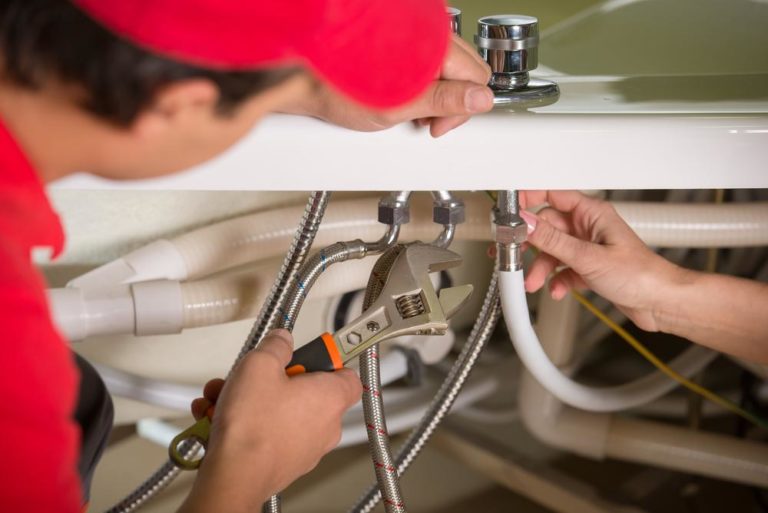Not all plumbing issues require expensive services of a plumber. In fact, there are a host of things that can be dealt with by a DIY approach. A little research and some tools may be all you need to save a good chunk of money. Keeping in mind that most plumbers charge for simply coming over to assess the situation, if you can resolve an issue on your own, it’s certainly worth a shot.
Fixing A Leaky Faucet
This is one of the simplest plumbing fixes. First, find out what type of faucet you have, then refer to online instructions on how to fix it. You will just need to replace a single washer and the tools you would need are the ones you probably already have around the house (screwdriver, wrench, Allen wrench, WD-40). This is unlikely to be a time consuming or an expensive fix, though depending on the plumbing issue, it may require more extensive work. Be prepared to take apart part of the faucet for this process.
Unjamming A Garbage Disposal
This one certainly does not need a plumber to clear. Most times, the debris caught up in the disposal makes the rotors unable to move, but almost all disposals have a small spot for a hex wrench to manually turn the rotor and free up whatever is holding it up from turning. It usually takes a few turns to loosen up the issue. Just make sure the disposal is off when you do so.
Fixing a Running Toilet Fix
Most often, a perpetually running toilet has to do with an issue in the flapper of the tank, or the chain that pulls it open. Such issues should be easy enough to spot and no tools may even be required. The fix is almost as simple as just replacing the flapper, chain or both.
Unclogging The Drain
Cable augers and snakes, found in most hardware stores, can be used to reach down into pipes to clear out any blockage. Plungers also work very well to force the debris to shift around and unclog.
Try to steer clear from drain cleaners, especially the heavy-duty ones. These can prompt chemical reactions that damage your drain pipes and drains, and may not do the job of clearing out all of the debris. Never pour drain cleaners into a sink that has a garbage disposal in it; that will result in a whole new level of problems. For a more proactive approach, once the clogging issue is resolved, ensure that no food enters the drain. Avoid pouring grease or fat in the sink so that it does not harden and make it difficult to clear.
Water Damage in Bathroom Cabinets Repair
Once you have identified and repaired the source of the leak causing the damage, you can sop up the water that has leaked, and dry the remaining space with a hairdryer. If mold has started to grow, to be sure to cut out the parts where the growth has begun. Other than that, lightly sand and repaint the damaged area. You could also use vinyl cabinet wraps to cover the water damage and keep it from getting worse.
Upgrading Showerhead
A very simple DIY project. If you are looking to improve water pressure or to save water, you can change most showerheads by simply untwisting the old showerhead, cleaning the threading on the shower arm, and using a rubber washer to seal the shower to the shower arm. If no rubber washer is provided, you can just use plumbers or Teflon thread tape for this purpose.
Fixing A Pop-Up Sink Stopper
Adjusting a warped or crooked pop-up sink stopper is surprisingly simple. Beneath the sink, you can find a lever that controls the up/down motion of the sink stopper. Simply maneuver the lever to get the sink stopper back in alignment. If a piece of the stopper is broken, you can purchase a stopper replacement kit, and follow the instructions to replace it.
Installing a Faucet Aerator
Most faucet aerators, devices used to reduce the usage of water by adding air into the stream, can be removed by just screwing and unscrewing from the faucet tip by hand. If not, a small socket wrench would be used. To find out the needed replacement size, just compare the aerator against a coin. If it is the size of a nickel, you will need a normal aerator. If it’s the size of a dime, you will need a junior-size one.
Caulking A Tub or Shower
This is one of the simplest plumbing projects to do yourself. Purchasing some silicone or plastic caulk, a caulking gun, and a tool for scraping off excess caulk (like a five in one tool). You will want to research the kind of caulk you need first, however. Being in a constantly wet environment however, it should be the mold and mildew resistant caulk. Use the caulking gun to slowly squeeze the caulk into the narrow space around the perimeter of the bath or shower, wipe off any excess, and after letting it dry for 24 hours, scrape off the excess.
Replacing the Entire Sink
While slightly more complex than the other DIY projects, it is entirely possible to replace a sink by yourself. There are great instructions available online which can guide you step by step in doing this in a matter of hours.


Comments are closed.